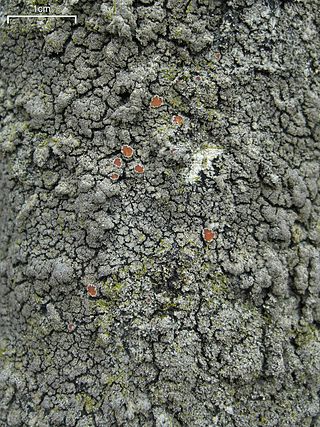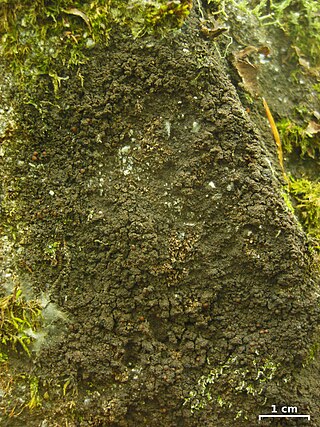
The Pannariaceae are a family of lichens in the order Peltigerales. Species from this family have a widespread distribution, but are especially prevalent in southern temperate regions.

Acanthothecis is a genus of lichen-forming fungi in the family Graphidaceae. The genus was circumscribed by Frederick Edward Clements in 1909.

Protopannaria is a genus of seven species of lichenized fungi in the family Pannariaceae. The genus was originally circumscribed as a subgenus of the genus Pannaria by Hungarian lichenologist Vilmos Kőfaragó-Gyelnik. Per Magnus Jørgensen and Stefan Ekman promoted Protopannaria to full status as a genus in 2000.

Parmeliella is a genus of lichenized fungi in the family Pannariaceae. It occurs mainly in the tropics and sub-tropics, with species found in Africa, Asia, Australasia and South America. A recent (2020) estimate places 41 species in the genus.

Pannaria is a genus of lichen-forming fungi in the family Pannariaceae. The widespread genus contains an estimated 51 species, found primarily in tropical regions.

Anisomeridium is a genus of lichens in the family Monoblastiaceae. The type species was originally named Arthopyrenia xylogena by Swiss botanist Johannes Müller Argoviensis in 1883; in 1928, Maurice Choisy defined the genus Anisomeridium, designating A. xylogena the type species.
Staurolemma is a genus of lichenized fungi in the family Pannariaceae. The genus was circumscribed by German lichenologist Gustav Wilhelm Körber in 1867, with Staurolemma dalmaticum as the type species.
Lepidocollema wainioi is a species of lichen in the family Pannariaceae. It is known from southeast Asia.

Vahliella is a genus of nine species of lichen-forming fungi in the order Peltigerales. It is the only member of Vahliellaceae, a family circumscribed in 2010 to contain this genus. Vahliella was formerly placed in the family Pannariaceae until molecular phylogenetics showed that it did not belong there. Vahliella species are found in the Northern Hemisphere – mainly in North America, but also in Europe and India.
Per Magnus Jørgensen is a Norwegian botanist and lichenologist, and Professor Emeritus of systematic botany at the University of Bergen. He is known for his work on the lichen families Pannariaceae and Collemataceae. Jørgensen was awarded the Acharius Medal in 2021 for his lifetime contributions to lichenology.
Atrophysma is a fungal genus in the family Pannariaceae. It contains the single species Atrophysma cyanomelanos, a crustose lichen found only in Alaska.
Rockefellera is a fungal genus in the family Pannariaceae. It is a monotypic genus, containing the single species Rockefellera crossophylla. The genus was circumscribed by James Lendemer and Erin Tripp in 2017. The generic name honors the Rockefeller family, "for their century-long support of North American conservation efforts, particularly with respect to national parks."
Steineropsis laceratula is a species of crustose placodioid lichen in the family Pannariaceae. It was first formally described in 1902 by French lichenologist Auguste-Marie Hue as Pannaria laceratula. Per Magnus Jørgensen proposed a transfer to Fuscopannaria in 1994. The taxon shuffled genera again in 2020 by Toby Spribille and Stefan Ekman after molecular phylogenetic analysis of the DNA from specimens collected in Alaska revealed its correct classification in the genus Steineropsis. The type specimen was collected in 1904 from Hakkoda, Japan, at an elevation of 1,200 m (3,900 ft); here the lichen was found growing on the bark of birch, but the species also grows on rock.

Lepidocollema marianum is a species of cyanolichen in the family Pannariaceae. It was first scientifically described by Elias Fries in 1825 as Parmelia mariana. Per Magnus Jørgensen transferred it to the genus Lepidocollema in 2014 following a molecular phylogenetics-guided revision of the Pannariaceae.

Robert Lücking is a German lichenologist. He earned his master's and PhD from the University of Ulm, focusing on the taxonomy, ecology, and biodiversity of foliicolous lichens. He has received numerous awards for his work, including the Mason E. Hale Award for his doctoral thesis, the Augustin Pyramus de Candolle prize for his monograph, and the Tuckerman Award twice for his publications in The Bryologist. Since 2015, he has been serving as the curator of lichens, fungi, and bryophytes at the Berlin Botanical Garden and Botanical Museum, and several lichen species and a genus have been named in his honour.
Fuscopannaria dispersa is a species of corticolous (bark-dwelling), squamulose lichen in the family Pannariaceae. It is found in China, where it grows on the bark of several tree species at an elevation range from 3,650 to 4,300 m, close to the forest limit. It was formally described as a new species in 2000 by Norwegian lichenologist Per Magnus Jørgensen. The type specimen was collected by Joseph Rock from the eastern slopes of Likang Snow Range in 1922, and has since been documented in a few locations in eastern China. The lichen has a brown thallus made of small squamules spread out over a distinct black prothallus. Its ascospores are ellipsoid, colourless, lack septa, and measure 15–17 by 9–10 μm. Fuscopannaria dispersa is similar to the more widespread F. leucosticta, but can be distinguished from that species by the squamulose form of its thallus and by its smaller, rounder ascospores.
Fuscopannaria dissecta is a species of corticolous (bark-dwelling), squamulose lichen in the family Pannariaceae. Found in Japan, it was formally described as a new species in 2000 by Norwegian lichenologist Per Magnus Jørgensen. The type specimen was collected by Syo Kurokawa from Mount Kōya at an altitude of 800 m (2,600 ft); there it was found growing on the rotting bark of trees. The lichen has a pale brown thallus that forms irregular patches comprising squamules that about are about 2 mm wide. The squamules are dissected–cut deeply into fine lobes–and it is this character that is referenced in the species epithet dissecta.
Fuscopannaria saltuensis is a species of ground-dwelling, squamulose lichen in the family Pannariaceae. It is found in both the Eastern and Western Himalayas, where it grows on soil in open mountain forests with pastures and cliffs.
Fuscopannaria siamensis is a species of lichen in the family Pannariaceae. It is found in the mountainous forests of northern Thailand and in Tamil Nadu, India, where it grows in humid habitats in association with mosses.

Fuscopannaria leucosticta, commonly known as the rimmed shingle lichen, is a species of lichen in the family Pannariaceae. It has a squamulose (scaley) thallus that lacks soredia and isidia, but has abundant apothecia with distinct white rims. Although its main centres of distribution are eastern North America and southeast Asia, where it grows in damp forests, it has been reported from various other high-altitude, humid locations.










